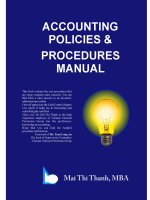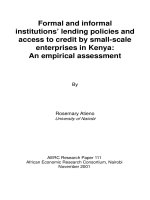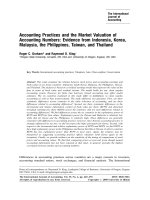Accounting policies and procedures
Bạn đang xem bản rút gọn của tài liệu. Xem và tải ngay bản đầy đủ của tài liệu tại đây (4.13 MB, 81 trang )
Testimonials for ACCOUTING POLICIES & PROCEDURES MANUAL
This book contains the core procedures that any large company must
concerns. You can find from a sales process to an inventory
adjustment procedure.
I myself appreciate the Cash Control chapter very much. It helps me in
forecasting and controlling the cash flow.
More over Ms Mai Thi Thanh as the high experience employee of
Vietnam National Petroleum Group has the proficiency knowledge in
accounting.
Hope that you can find the helpful procedures in this book.
Foreword of Mr. Tran Long An
The head of Supervisory Committee
- Vietnam National Petroleum Group,
Clear Procedures
Detailed explanation
Practical guide line
5W-1H structure
Full aspect of the company process
“This is the most reliable
book on the Accounting
Policies and Procedures. It
is very worth for your time
of reading.”
Ms. Truong Thi Hanh
CFO – KPMG Vietnam Co.
Ltd,
“The most successful factor
of this book is that its
procedures are listed in
details
with
many
explanations. It is very easy
for you to practice and
apply in your work.”
Mr. Vu Van Chien
General Director –
Petrolimex Asphalt Company
Limited
ACCOUTING POLICIES & PROCEDURES MANUAL
By MBA. Mai Thi Thanh
Copyright © 2013 Mai Thi Thanh. All right reserved. Printed in Vietnam. 1st version.
Published by Dat Thanh Tam Company Limited,
Address: 179 Dong Den st, Ward 10, Tan Binh District, HCMC, Vietnam
Phone: +84 945 250 250 – Tax code: 38119240
Contact:
ACCOUNTING POLICIES &
PROCEDURES MANUAL
TABLE OF CONTENTS
CONTENT
PAGE
INTRODUCTION ……………………………………………………………..……...
5
1. SALES AND ACCOUNT RECEIVABLE ……………………………………….
1.1 PROCESS OVERVIEW AND POLICIES …..…………………………….
1.2. SALES ORDER PROCESSING …………………………………………..
1.3. BILLING …………………………………………………………………..
1.4. PAYMENT PROCESSING ……………………………………………….
1.5. CREDIT CONTROL AND COLLECTION ………………………………
6
6
11
15
23
28
2. PURCHASE AND ACCOUNTS PAYABLE ……………………………………..
2.1. PROCESS OVERVIEW AND POLICIES ………………………………..
2.2. REQUEST AND ORDER GOODS/SERVICES ………………………….
2.3. RECEIVE AND RECOGNIZE GOODS/SERVICES …………………….
2.4. PAYMENT FOR PURCHASED GOODS/SERVICES …………………..
33
34
37
41
44
3. INVENTORY ………………………………………………………………………
3.1. PROCESS OVERVIEW AND POLICIES ………………………………..
3.2. INVENTORY RECEIPT ………………………………………………….
3.3. INVENTORY ISSUANCE ………………………………………………..
3.4. STOCKTAKE AND INVENTORY ADJUSTMENT …………………….
47
48
50
55
58
4. CASH CONTROL ………………………………………………………………….
4.1. PROCESS OVERVIEW AND POLICIES ………………………………..
4.2. CASH COLLECTION …………………………………………………….
4.3. CASH DISBURSEMENT …………………………………………………
4.4. BANK RECONCILIATION ………………………………………………
62
63
64
67
70
5. FIXED ASSET …………………………………………………………………….
5.1. PROCESS OVERVIEW AND POLICIES ……………………………….
5.2. RECOGNITION AND RECORDING ……………………………………
5.3. PHYSICAL CONTROL …………………………………………………..
5.4. REPAIR AND MAINTENANCE …………………………………………
71
72
74
77
79
ACCOUNTING POLICY AND PROCEDURE MANUAL |
4
INTRODUCTION
With the large geographical coverage and high-value turnover, it is vital that the company have a
organisation-wide consistent, well-developed and diligent accounting system to manage, record and
control its financial and accounting information timely, accurately and adequately. As part of the
accounting system, the accounting policy and procedure manual has been drafted.
The major objective of the accounting policy and procedure manual is to ensure:
The company management and staff have a comprehensive, accurate and complete set of
accounting records.
All the Company’s transactions are recorded promptly, clearly and accurately in the accounting
records.
All its accounting records are capable of providing all the financial information needed for
statutory requirements and for Company and branch management purposes
The company has an effective accounting system that fits with its particular business
situation/condition and provides reliable internal control measures
All of its accounting elements and transactions are in accordance with the Vietnamese Accounting
System Standard as well as with its statuary accounting system
The Accounting Policy and Procedure Manual is concentrated on addressing accounting information
generated from The company’s major business processes: sales and distribution, inventory
management, procurement process, fixed asset and cash management. To this end, the manual is
organized into and comprised of policies and procedures for the following accounting
processes/subprocesses:
Sales and Accounts Receivable Cycle: sales order processing, billing, customer payment
processing, credit control and collection
Purchase and Accounts Payable Cycle: goods/services request and order, goods/services receipt
and recognition, payment for purchased goods/services
Inventory Cycle: inventory receipt, inventory issuance, stocktake and inventory adjustment
Cash Cycle: cash receipt, cash disbursement, bank reconciliation
Fixed Asset Cycle: fixed asset recording and recognition, fixed asset physical control, fixed asset
repair and maintenance
For each of the accounting process/subprocess, the policies and procedures detail its major
transaction/recording activities. They define major information/document/vouchers/forms arising out
of or used in the process/subprocess. Role and responsibility of each of participant in the
process/subprocess are also identified. While the accounting policy and procedure manual was being
developed, several key accounting management decision such as accounting function
centralization/decentralization to branches/location and the kinds of sales management software to be
used have yet to be finalized by the company. The constraints may, at some extent, restrict the
applicability of the manual. To overcome the uncertainty, the accounting policy and procedure manual
has been drafted aiming to provide an adequate and general set of guidelines and standards for the
company’s major accounting processes. They facilitate further detailed development of policies and
procedures for all The company’s accounting processes when the company management makes the
key accounting decisions.
ACCOUNTING POLICY AND PROCEDURE MANUAL |
5
SALES AND ACCOUNTS RECEIVABLE
ACCOUNTING POLICY AND PROCEDURE MANUAL |
6
ACCOUNTING POLICIES & PROCEDURES
PROCESS: SALES AND ACCOUNTS RECEIVABLE
Process Overview and Policies
OVERVIEW OF THE PROCESS
Process Definition
Sales and Accounts Receivable cycle starts when customers place an order to the point
where goods are delivered to customers and when customer payment is received.
Sub-processes
The Sales and Accounts Receivable Cycle is comprised of 4 sub-processes:
Sales Order Processing Sub-process
Billing Sub-process
Payment Processing Sub-process
Credit Control and Collection Sub-process
Participants
Major entities involved in the process:
Marketing department of head office, sales and marketing department in all branchs
(all of them are referred to as the sales department)
Distribution department in the head office and in branches: all of them would be
referred as distribution department
Warehouses and terminals
Sales accountants: sales accountants may belong to sale and marketing departments
or join the finance and administration departments
PROCESS POLICIES
Credit Limit and
Credit Term
No credit sales is populated by the company.
Sales Recognition
A sales is recognized when:
In sales, customers are usually required to pay a portion of contract value in advance
(advance payment). The remaining amounts would be paid after receipt of goods.
How the contract value is paid is usually subject to negotiation between sales staff
and customers
Any credit sales should be approved by the sales and marketing manager or higher
positions and within the credit limit and credit term as stipulated in the credit policy
applied to the customer.
Products are actually delivered to customers (in case customer arranges transport for
themselves) or to transportation carriers (in case the company arranges transportation)
and
Customers or transportation carriers and warehouses/terminals confirm the actual
receipt of goods by signing and confirming the quantity of goods delivered on
respective delivery notes and delivery slips
Delivery Notes
Issuing
All delivery notes should be pre-numbered in sequential order. The sequence should
also be logged in record book and the series of sequence number of both used and
unused accountable forms should be reviewed regularly to detect mistakes, errors or
misuse of documents. Delivery notes should only be approval and signed off when
ACCOUNTING POLICY AND PROCEDURE MANUAL |
7
ACCOUNTING POLICIES & PROCEDURES
PROCESS: SALES AND ACCOUNTS RECEIVABLE
Process Overview and Policies
actual goods have been issued based on the shipping order and Goods Issue Notes.
Delivery notes should only be dated based on the date of actual delivery of goods and
be signed by the driver upon receiving of goods. In no circumstances, the delivery
notes are approved in advance. Any erroneous delivery notes must be accounted for
and filed appropriately.
Invoice Issuing
Invoice should be issued by the sales accountant upon receipt of the confirmed
delivery notes from warehouses/terminals
Total value of the invoice equals the value of the goods actually delivered to
customers/transportation carriers under a delivery note
Invoice values should have references to respective sales orders and be clearly broken
down into actual goods value, transportation cost and VAT tax
Invoices should be issued within 3 days of delivery
Reconciliation and
Reporting
Each branch and marketing department should reconcile and make the following reports
at the end of each month:
Sales reports including goods in value and volume as ordered by customers, as
actually delivered and as outstanding
Credit reports containing information on customers payment and outstanding payment
Approval
All sales order, transportation orders and customer credit should be approved and
signed by the branch manager or head office marketing department managers
Delivery notes should be approved and signed by sales and marketing manager
ACCOUNTING POLICY AND PROCEDURE MANUAL |
8
ACCOUNTING POLICIES & PROCEDURES
PROCESS: SALES AND ACCOUNTS RECEIVABLE
Sub-process: Sales Order Processing
ACCOUNTING POLICY AND PROCEDURE MANUAL |
9
ACCOUNTING POLICIES & PROCEDURES
PROCESS: SALES AND ACCOUNTS RECEIVABLE
Sub-process: Sales Order Processing
OBJECTIVES
To accurately, timely and completely record sales order information from customers
To accurately, timely and completely issue delivery documents and arrange delivery
of goods to customers
To accurately, timely and completely record volume and value of goods to be paid by
and delivered to customers
PROCEDURE
1. Inform sales order
Who:
Customers.
What:
Customers order.
How:
Customers make sales orders by two ways: either by making call or fill in purchase order
form and send to the company by fax.
In submitting sales order, customers are required to notify their identity code, the volume
to be purchased, number of loads, delivery time and place for each load and payment
detail.
If customers arrange their own means of transportation, they must also advise of
transport means details (truck or ships). The details must include truck plate
number/ship identification, drivers/captain identity (name, license number, etc…).
Why:
To define correct and sufficient details for the company’s sales & marketing staff to
prepare a sales order.
2. Check customer data
Who:
Sales or marketing staff of Head Office or of branchs.
What:
Check customer’s identity and their order/delivery status.
When:
Immediately after the receipt of a customer’s orders by call or fax.
How:
For sales, check customer’s current sales order and/or goods receipt status. If this is new
sales order, go to activity 3; if not, inform the customer of which quantity/delivery of
cement under existing sales orders he/she has not received and reconcile the volume for
new sales order.
For customers: check clinker contract numbers and outstanding deliveries of the contract.
Notify the customer of the applicable price for the order.
Why:
To confirm the validity of the person/entity making the order and achieve reconciliation
of sales volume/delivery under the existing sales orders/clinker contracts.
3. Record order information
ACCOUNTING POLICY AND PROCEDURE MANUAL |
10
ACCOUNTING POLICIES & PROCEDURES
PROCESS: SALES AND ACCOUNTS RECEIVABLE
Sub-process: Sales Order Processing
Who:
Sales or marketing staff who receives the sales order from the customer.
What:
To record information of the new sales order into the Sales Order Form (either in
appropriate spreadsheet or window of Exact system).
How:
Record the wholesaler’s new order information into the Sales Order Form in the System:
volume, price, delivery schedule, and payment condition.
Open the Shipment Form to record delivery details: time, transport means type and
number and receiver’s identity.
Notes:
Sales and marketing staff should immediately records new sale order/delivery request
data into the System.
ACCOUNTING POLICY AND PROCEDURE MANUAL |
11
ACCOUNTING POLICIES & PROCEDURES
PROCESS: SALES AND ACCOUNTS RECEIVABLE
Sub-process: Sales Order Processing
4. Check customer payment
Who:
Sales and marketing staff.
What:
Check the payment status from customer for the new order.
When:
After recording wholesaler new sales order.
How:
Inform sales accountant of the customer’s new order.
Check from the Collection Report in the System or ask Sales Accountant for payment
confirmation.
If the customer was not given credit sales, sales accountant would confirm whether he
has received the payment for the new sales order and the customer’s current balance is
enough for the sales order value. If the customer is given credit sales, sales accountant
would confirm whether the new sales order is still within the given credit limit given to
him/her.
If sales account confirms, go to next activity. Otherwise, the new sales order is rejected
and the reject would be notified to the customer.
Why:
To reduce the risk of outstanding payment from customers.
5. Check delivery capability and transport availability
Who:
Sales and marketing staff.
What:
Check with Distribution/Transport Section of goods and transport availability for
delivery under the new sales order.
When:
After or at the same time with checking customer’s payment status for the new order.
How:
Inform the distribution/transport section the new sales order volume and delivery
schedule and place.
The distribution/transport section notifies/confirms back to the sales & marketing staff
the availability of goods to be delivered in the warehouse in question.
If the company arranges delivery, the distribution/transport section will inform or
confirm the delivery schedule to the sales & marketing staff.
If the goods and/or transport are not available as ordered/requested by customer, sales &
marketing staff discusses/negotiates again with customer.
6. Confirm sales order, record delivery information and issue Sales Order
Who:
Sales & marketing staff.
What:
Confirm the new sales order to customer and issue the new sales order.
When:
After customer payment for the new order is confirmed by sales accountant
After goods and/or transport
distribution/transport section.
means
are
confirmed
to
be
available
ACCOUNTING POLICY AND PROCEDURE MANUAL |
12
by
ACCOUNTING POLICIES & PROCEDURES
PROCESS: SALES AND ACCOUNTS RECEIVABLE
Sub-process: Sales Order Processing
How:
Call customer to confirm the new order.
Confirm the delivery schedule and place.
Issue/print out the new sales order from the System.
Send the sales order to customer for his/her confirmation and/or signing (in case of
sales, where customers fax the order to the company, sales & marketing staff would send
back to wholesaler/customer the company’s confirmation).
7. File sales order and issue delivery orders
Who:
Sales and marketing staff.
What:
File the sales order confirmed by customers and issue delivery order to warehouses.
When:
After both the company and customer confirm new sales order
How:
File sales order confirmed by wholesaler/customer.
Open the delivery order form from the System, record delivery timing, place and
transport details, issue identity codes for receivers into the form and print it out.
Fax the delivery orders to the warehouse in question.
(if the company set-up an inventory module in warehouse and integrate them into the
common IT system, warehouses can open it so it is not necessary to fax them to the
warehouses)
File the delivery order, make a copy to the distribution/transport section.
Why:
To instruct/notify warehouses to deliver goods to transport companies and/or customers
under the sales order.
Notes:
The delivery order should include shipping/delivery details for the total amount ordered
by the customer.
Shipping/delivery details must contain timing and place of delivery, value and volume to
be delivered, transportation means and identity, identification and coding number of
receivers.
A delivery order is issued in 4 slips: 1 for sales & marketing dept., 1 for warehouse in
question, 1 for receiver (driver for example) and 1 for the customer/wholesaler.
The identity codes of receivers are used by all branchs to ensure that delivery of goods
under the sales order is made correctly to the right receivers/drivers.
The delivery order should have reference to the sales order number for which it is issued.
8. Issue shipment notice
Who:
Sales and marketing staff
What:
Issue and send shipment notice to wholesaler/customer.
Update/record shipment schedule into the sales order.
When:
After the delivery orders have been issued and faxed to warehouses.
ACCOUNTING POLICY AND PROCEDURE MANUAL |
13
ACCOUNTING POLICIES & PROCEDURES
PROCESS: SALES AND ACCOUNTS RECEIVABLE
Sub-process: Sales Order Processing
How:
Update/confirm shipment details.
Print the shipment notice and attach it with the corresponding sales order.
Fax or notify (by phone) the shipment notice to customer. Sales & marketing staff to
wholesaler/customer, if needed, will provide the codes of goods receiver, by telephone.
Why:
To get customer aware of and prepare for the receipt of goods to be ordered.
Notes:
Basically, the shipment notice contains data given in the delivery orders sent to
warehouses.
9. Reconcile/update sales and delivery data
Who:
Sales and marketing staff.
What:
Review and reconcile volume of goods actually delivered by the company to customer
with that ordered by customer.
When:
After sales & marketing staff receives a copy of the endorsed delivery order/delivery slip
faxed back by warehouses.
How
Upon receipt of goods, receivers/drivers endorse the receipt by confirming/signing the
actual goods delivered on the delivery order.
The confirmed delivery orders are then faxed to the sales and marketing department.
Upon receipt of the copy of the confirmed delivery order, sales and marketing staff tracks
the sales order, match the volume actually delivered with that in the sales order.
Mark the sales order as “completed” if the whole volume ordered has been actually
delivered. Otherwise, reconcile the difference or update the new shipping schedule with
customer.
Record the reconciliation/update into the sales order masterfile and shipment data in the
System.
Why
Customer may not receive fully the goods volume to be ordered; or
Depending on goods and transport availability, they cannot receive the ordered volume
within an agreed timeframe.
10. Issue billing Request
Who:
Sales and marketing staff.
What:
Fill in billing application, attach the sales order and confirmed delivery order.
When:
After sales & marketing staff receives the confirmed delivery order from the warehouse.
How:
Open the billing application form from the System and enter billing amount, product
quantity and category, sales order number and delivery order number.
Send the billing application to the sales accountant.
ACCOUNTING POLICY AND PROCEDURE MANUAL |
14
ACCOUNTING POLICIES & PROCEDURES
PROCESS: SALES AND ACCOUNTS RECEIVABLE
Sub-process: Sales Order Processing
Why:
To issue the invoice for the customer for their legal compliance or for the company to
collect payment from them.
To recognise sales value.
11. Issue daily sales report
Who:
Sales staff and sale & marketing manager.
What:
Issue the sales report to present it to branch manager and/or marketing manager of the
head office.
When:
At the end of the following business day.
How:
Summarise sales orders to be issued to date by customer, by area and by region
Compare actually goods to be delivered with the corresponding sales orders and
outstanding goods volume yet to be received by the customers to date
Why:
To provide a clear summary of sales order status and execution.
ACCOUNTING POLICY AND PROCEDURE MANUAL |
15
ACCOUNTING POLICY AND PROCEDURE MANUAL |
16
ACCOUNTING POLICIES & PROCEDURES
PROCESS: SALES AND ACCOUNTS RECEIVABLE
Sub-process: Billing
OBJECTIVES
To accurately, timely and adequately recognize sales value
To ensure that all customers are completely, accurately and timely invoiced
PROCEDURE
1. Confirm receipt of billing request
Who:
Sales Accountant.
What:
Endorse the billing request and send a note confirming the receipt of billing to sales and
marketing staff.
When
After receipt of billing request from sales and marketing staff.
How:
Endorse “Received – Date” on the billing request.
Prepare and send note acknowledging the receipt of billing request to sales and
marketing staff.
File the billing request.
Why:
To ensure documents are not lost.
2. Verifying supporting documents and schedule billing
Who:
Sales Accountant.
What:
Review all supporting document (sales order and confirmed delivery order) to check the
accuracy of the billing amount (the supporting document may be in paper or in the
System sales order masterfile and shipment masterfile).
Review the customer’s credit balance.
When:
After finishing confirmation of receipt of billing request.
How:
Search sales order masterfile and shipment masterfile to identify the sales order and
delivery order. Match the billing (the step can be ignored if the documents are attached to
billing request.
Review the corresponding sales order and confirmed delivery order to check the accuracy
of the amount to be claimed.
For sales: review the billing schedule in the clinker sales contract to check appropriate
time for billing.
Verify customer name, address, codes, the amount and volume to be claimed.
Notify sales and marketing staff of any discrepancy between the amount to be claimed
and claiming time with those in the supporting documents.
Why:
To ensure customer is billed correctly.
3. Enter billing data
ACCOUNTING POLICY AND PROCEDURE MANUAL |
17
ACCOUNTING POLICIES & PROCEDURES
PROCESS: SALES AND ACCOUNTS RECEIVABLE
Sub-process: Billing
Who:
Sales Accountant.
What:
To record billing data in the invoice form on the System
When:
After all customer, sales value and volume information has been verified as accurately.
How:
Obtain a new Invoice Form and enter customer name, address, and customer code.
Enter product code, volume and value of goods delivered.
Break down the value into product price, bonus/discount, transportation cost and VAT
tax.
Enter the date of the invoice.
Notes:
Regardless of customer’s preference in invoice details, the invoice should be broken
down into values for separate items: product price, transport cost and tax.
ACCOUNTING POLICY AND PROCEDURE MANUAL |
18
ACCOUNTING POLICIES & PROCEDURES
PROCESS: SALES AND ACCOUNTS RECEIVABLE
Sub-process: Billing
4. Recognise sales
Who:
Sales Accountant.
What:
Recognise the sales and post to the corresponding ledgers
When:
After entering billing data
How:
Match the invoice value with the corresponding sales order and customer’s payment.
Recognise the sales value.
Post the amount into the customer’s sales and account receivable ledger accordingly
Why:
To make sure that the sales is recognised and customer’s credit balance will be updated
completely, timely and accurately.
5. Print and sign-off invoices
Who:
Sales accountant.
What:
Print out the invoice and present to head of department/branch for signing-off.
When:
After all the billing data have been entered.
How:
Print out the invoice after all required data have been recorded.
Present the invoice to the head of branch/department for review and sign-off.
The invoices are made into 2 slips: one is filed by sales accountant filing, the other is
sent to customer.
Why:
To approve/validate the invoice to send to customer.
6. Dispatch and file invoices
Who:
Sales Accountant.
What:
File the invoice issued and send a copy to customer.
When:
The company’s copy of the invoice should be filed immediately by the Sales Accountant.
The dispatch of the invoice to customers depends on customer’s preference. For some
customers, the invoices should be sent them immediately for transportation formality
clearance. For others, the invoices could be filed, packed and sent to customers at the end
of the month in question.
How:
File the invoice in the Invoice Log and/or mark issue/dispatch status of the invoice.
Dispatch it immediately to customer by courier or hand-deliver to his/her
representative/drivers, etc… or
File all the invoices printed out in the month and send all in a package to customer at the
end of the month.
ACCOUNTING POLICY AND PROCEDURE MANUAL |
19
ACCOUNTING POLICIES & PROCEDURES
PROCESS: SALES AND ACCOUNTS RECEIVABLE
Sub-process: Billing
Why:
For customer to initiate payment, to fulfill tax claim or to use it for transport formality
clearance.
7. Print transaction report from the System
Who:
Sales Accountant.
What:
Print out a transaction report containing data of all billing invoices issued and dispatched
in the month.
When:
At the beginning of the following month.
How:
Summarise the invoices issued and the billing values in the month for each customer and
for each sales order made by the customer in the month.
Print out the summary (transaction report) and submit it to sales & marketing manager.
8. Reconcile transaction report against sales order report
Who:
Sales Accountant with sales and marketing staff.
What:
Check/reconcile the discrepancy between the volume and value of goods ordered by
customers with those actually billed in the month.
When:
On the first week of the following month.
How:
Use the customer code to list all customers’ sales orders and invoices issued in the
month.
List and compare the total value of all customers’ sales orders and total value of invoices
issued.
If there is mismatch between the two values, sort out invoices for each customer’s sales
order based on the sales order number in the invoices to find out any mismatch between
the sales order value and the total value of invoices issued based in the sales order.
Verify whether the mismatch is due to missed billing or due to changes in sales order or
due to under-delivered or over-delivered of goods to customer under the contract/sales
orders.
Prepare a transaction reconciliation report summarising the findings and actions
addressing the mismatches.
Why:
To ensure there is no missed billing and if yes, develop an action plan to cover.
9. Review and approve transaction reconciliation report
Who:
Branch manager or head office marketing manager.
What:
Review and sign-off the transaction reconciliation reports.
When:
Upon receipt of the report from the sales and marketing manager.
ACCOUNTING POLICY AND PROCEDURE MANUAL |
20









